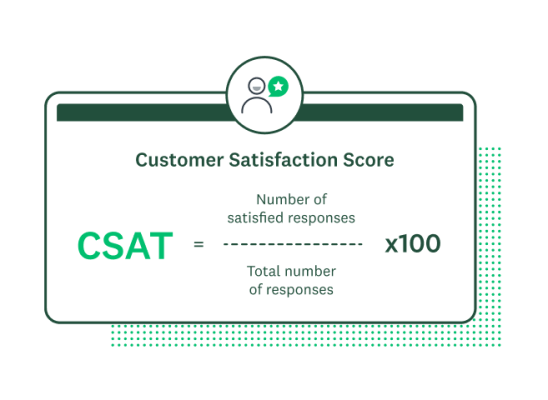Everything you need to know about CSAT score
Improve your customer experience by measuring your company’s CSAT score and addressing feedback. Send CSAT surveys with SurveyMonkey.

Measuring customer satisfaction is essential to providing the best customer experience (CX) possible. When customers are satisfied, they are more likely to make repeat purchases and share your brand with their network, creating more sales opportunities.
Luckily, there’s a tried and true method of measuring customer satisfaction: the customer satisfaction score (CSAT.) In this article, we will explain how CSAT works and how to calculate, interpret, and improve your score over time.
What does Customer Satisfaction Score (CSAT) mean
A customer satisfaction score (CSAT) is a metric that measures how satisfied customers are with your business’s products or services. A CSAT score is generally determined by sending a customer satisfaction survey and measuring its results.
Typically, you measure the customer feedback you receive as a percentage, with 100% being the highest score you can achieve.
Overview of CSAT surveys
Surveys are a fantastic way of measuring customer satisfaction because they are easy to fill out and can be sent in multiple ways (via email, SMS, embedded on a webpage, etc.). A CSAT survey measures customer satisfaction on a scale of 1 to 5, 1 to 7, or 1 to 10.
CSAT surveys often include a mix of close- and open-ended questions for customers to answer. A few general example CSAT questions include:
- Please rate your overall satisfaction with [company]
- How would you rate the helpfulness of our customer service representatives?
- How would you rate your satisfaction with our mobile app?
- How satisfied are you with the pricing of our [product/service]?
Benefits of measuring CSAT
From identifying areas for improvement to boosting employee morale, measuring customer satisfaction levels can be highly beneficial. Here are several top benefits to consider:
- Identify areas for improvement: CSAT surveys can help identify areas for improvement as a company by including questions about a specific area of your business or prompting customers to add candid feedback.
- Gauge customer experience: Customer satisfaction surveys can also help you measure and understand customer experience (CX) by determining whether customers feel satisfied with your company’s products or services.
- Measure progress over time: You can track performance over time by consistently measuring this customer experience metric with CSAT surveys. Assess the impact of changes to your product or service offerings.
- Inform decision-making: CSAT scores are excellent for informing strategic business decisions, such as where to invest more resources or what company initiatives to prioritize.
- Benchmark your results: By measuring your CSAT score, you can use industry benchmarks to compare where your business lands among other companies in your vertical.
- Boost employee morale: When employees can see their impact on the company through customer satisfaction scores, their morale improves. High CSAT scores indicate great work from the team and can be a rewarding metric for employees to monitor.

How to calculate CSAT score
CSAT formula
Calculating your CSAT score from the feedback you received from the survey you sent to customers is pretty simple. You'll use the two highest customer scores of 4 (Satisfied) and 5 (Very satisfied) to calculate the score. Research has found this to be the most accurate way to predict customer retention.
Here’s the formula:

(Number of satisfied customers (those who responded with a 4 or 5) / Total number of survey respondents) x 100 = % of satisfied customers.
Imagine you sent a customer satisfaction survey to 300 people, and only 225 respondents rated your company a 4 or a 5:
(225 / 300) = 0.75
0.75 x 100 = 75% of your customers are satisfied.
How to calculate CSAT score out of 5
For a CSAT score on a “0-5” rating scale, follow these steps to get your results:
- Calculate S (the sum of all satisfaction scores)
- Calculate N (the total number of responses)
Start by adding all of the satisfaction scores together. So, for instance, we’ll say the sum was 1,290.
Then, divide S by the total number of responses (N). The total number of responses was 300.
1,290 / 300 = 4.3
Your average CSAT out of 5 is 4.3, indicating that most customers are satisfied.
How to interpret your CSAT score
To interpret your CSAT score, you will need to evaluate your results, whether a percentage of 100 or an average out of 5. In the case of our examples, one company’s results were 75%. Another company’s average was 4.3.
These scores indicate that, in general, most customers are currently satisfied with each business. 75% is representative of three-quarters of a company’s customers being satisfied. A 4.3 average CSAT score places the average customer in the satisfied category (over 4).
What does a high CSAT score mean?
A high CSAT score indicates that many customers are happy with your products or services and that your company likely provides a positive customer experience. It can also highlight strong customer loyalty because satisfied customers are more likely to become repeat customers, which generally translates into higher retention rates.
A high CSAT score is a reward for the effort you and your team put into ensuring each customer receives the best products or services every time. It can show that a recent initiative has positively impacted customer satisfaction and inform your strategies moving forward.
What does a low CSAT score mean?
A low CSAT score means that there is room for improvement. You can make strategic changes to enhance customer satisfaction, foster customer loyalty, and raise retention rates.
A subpar CSAT score can motivate you to improve your product or service offerings and focus on providing top-notch customer service. A low CSAT score is not the end-all-be-all of business success; however, it is an important metric to monitor.
What is the CSAT score scale?
The CSAT score scale ranges from 1 (being the lowest) to 5 (being the highest). Typically, it follows the format below:
1 - Very unsatisfied | 2 - Unsatisfied | 3 - Neutral | 4 - Satisfied | 5 - Very Satisfied
Other scale options include the 1 to 7 CSAT and 1 to 10 CSAT scales. Here is what those scales look like:
| 1 - Extremely unsatisfied 2 - Very unsatisfied 3 - Unsatisfied 4 - Neutral 5 - Satisfied 6 - Very satisfied 7 - Extremely satisfied | 1 - Extremely unsatisfied 2 - Very unsatisfied 3 - Unsatisfied 4 - Somewhat unsatisfied 5 - Neutral 6 - Somewhat satisfied 7 - Satisfied 8 - Very satisfied 9 - Extremely satisfied 10 - Perfectly satisfied |
There is no right or wrong way to measure customer satisfaction using a CSAT score. Choose the scale that resonates most with you.

How to improve CSAT score
Improving your CSAT score shows that the initiatives or changes you’ve made in your business have paid off. Track your CSAT score regularly to see how it changes over time., so you continuously improve it.
Improve customer satisfaction
Focus on customer satisfaction to boost your CSAT score. Improvement strategies can range from evaluating your website’s user experience (UX) to focusing on product development and adding new features to meet customer needs. Look at all your customer touchpoints to see what areas are lacking and can be improved upon.
Gathering customer feedback throughout the lifecycle helps you make informed decisions that impact your bottom line.
Enhance customer service efforts
Customer service is another fantastic area to focus on when trying to improve your CSAT score. Check your customer support teams' performance and evaluate the current Customer Effort Score (CES).
Improve your customer service satisfaction ratings by ensuring that employees follow best practices for customer interactions and focus on the customer rather than the issue. This will boost customer service metrics and help improve your CSAT score simultaneously.
Gather and act on customer feedback
Customer feedback from customer experience (CX) surveys, whether as a Net Promoter Score® (NPS) or CES, is highly valuable. Gathering feedback throughout the customer lifecycle is critical to improving your brand and its value.
Acting on insights gathered from CX surveys is one of the most basic ways to boost your CSAT score. Customers have taken the time to provide feedback about your company, its products/services, customer experience, etc. Don’t waste this valuable resource!
Using templates from SurveyMonkey simplifies the process of sending surveys and collecting customer feedback. Here are just a few of our top CX survey templates:
Related reading: 23 ways to increase your CSAT response rates
Improve customer satisfaction with SurveyMonkey
Sign up for SurveyMonkey to get started today by creating customer feedback surveys, including NPS and CSAT, to measure and elevate customer satisfaction.
Discover more resources

Solutions for your role
SurveyMonkey can help you do your job better. Discover how to make a bigger impact with winning strategies, products, experiences, and more.

Why are surveys important in research?
Surveys are important in research because they offer a flexible and dependable method of gathering crucial data. Learn more today.

NPS surveys: Best practices for high response rates
Learn NPS survey best practices to drive high response rates by improving survey processes.

23 ways to increase CSAT response rates
It's hard to improve your customer satisfaction scores without respondents. Get SurveyMonkey's best actionable tips to improve your response rate.